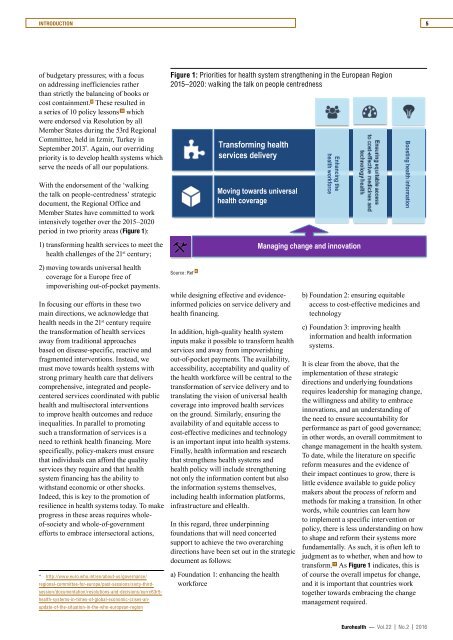EUROHEALTH
Eurohealth-volume22-number2-2016
Eurohealth-volume22-number2-2016
You also want an ePaper? Increase the reach of your titles
YUMPU automatically turns print PDFs into web optimized ePapers that Google loves.
INTRODUCTION<br />
5<br />
of budgetary pressures; with a focus<br />
on addressing inefficiencies rather<br />
than strictly the balancing of books or<br />
cost containment. 9 These resulted in<br />
a series of 10 policy lessons 10 which<br />
were endorsed via Resolution by all<br />
Member States during the 53rd Regional<br />
Committee, held in Izmir, Turkey in<br />
September 2013 * . Again, our overriding<br />
priority is to develop health systems which<br />
serve the needs of all our populations.<br />
With the endorsement of the ‘walking<br />
the talk on people-centredness’ strategic<br />
document, the Regional Office and<br />
Member States have committed to work<br />
intensively together over the 2015–2020<br />
period in two priority areas (Figure 1):<br />
1) transforming health services to meet the<br />
health challenges of the 21 st century;<br />
Figure 1: Priorities for health system strengthening in the European Region<br />
2015 – 2020: walking the talk on people centredness<br />
Transforming health<br />
services delivery<br />
Moving towards universal<br />
health coverage<br />
Enhancing the<br />
health workforce<br />
Managing change and innovation<br />
Boosting health information<br />
2) moving towards universal health<br />
coverage for a Europe free of<br />
impoverishing out-of-pocket payments.<br />
In focusing our efforts in these two<br />
main directions, we acknowledge that<br />
health needs in the 21 st century require<br />
the transformation of health services<br />
away from traditional approaches<br />
based on disease-specific, reactive and<br />
fragmented interventions. Instead, we<br />
must move towards health systems with<br />
strong primary health care that delivers<br />
comprehensive, integrated and peoplecentered<br />
services coordinated with public<br />
health and multisectoral interventions<br />
to improve health outcomes and reduce<br />
inequalities. In parallel to promoting<br />
such a transformation of services is a<br />
need to rethink health financing. More<br />
specifically, policy-makers must ensure<br />
that individuals can afford the quality<br />
services they require and that health<br />
system financing has the ability to<br />
withstand economic or other shocks.<br />
Indeed, this is key to the promotion of<br />
resilience in health systems today. To make<br />
progress in these areas requires wholeof-society<br />
and whole-of-government<br />
efforts to embrace intersectoral actions,<br />
* http://www.euro.who.int/en/about-us/governance/<br />
regional-committee-for-europe/past-sessions/sixty-third-<br />
session/documentation/resolutions-and-decisions/eurrc63r5-<br />
health-systems-in-times-of-global-economic-crises-anupdate-of-the-situation-in-the-who-european-region<br />
Source: Ref 6<br />
while designing effective and evidenceinformed<br />
policies on service delivery and<br />
health financing.<br />
In addition, high-quality health system<br />
inputs make it possible to transform health<br />
services and away from impoverishing<br />
out-of-pocket payments. The availability,<br />
accessibility, acceptability and quality of<br />
the health workforce will be central to the<br />
transformation of service delivery and to<br />
translating the vision of universal health<br />
coverage into improved health services<br />
on the ground. Similarly, ensuring the<br />
availability of and equitable access to<br />
cost-effective medicines and technology<br />
is an important input into health systems.<br />
Finally, health information and research<br />
that strengthens health systems and<br />
health policy will include strengthening<br />
not only the information content but also<br />
the information systems themselves,<br />
including health information platforms,<br />
infrastructure and eHealth.<br />
In this regard, three underpinning<br />
foundations that will need concerted<br />
support to achieve the two overarching<br />
directions have been set out in the strategic<br />
document as follows:<br />
a) Foundation 1: enhancing the health<br />
workforce<br />
b) Foundation 2: ensuring equitable<br />
access to cost-effective medicines and<br />
technology<br />
c) Foundation 3: improving health<br />
information and health information<br />
systems.<br />
It is clear from the above, that the<br />
implementation of these strategic<br />
directions and underlying foundations<br />
requires leadership for managing change,<br />
the willingness and ability to embrace<br />
innovations, and an understanding of<br />
the need to ensure accountability for<br />
performance as part of good governance;<br />
in other words, an overall commitment to<br />
change management in the health system.<br />
To date, while the literature on specific<br />
reform measures and the evidence of<br />
their impact continues to grow, there is<br />
little evidence available to guide policy<br />
makers about the process of reform and<br />
methods for making a transition. In other<br />
words, while countries can learn how<br />
to implement a specific intervention or<br />
policy, there is less understanding on how<br />
to shape and reform their systems more<br />
fundamentally. As such, it is often left to<br />
judgment as to whether, when and how to<br />
transform. 11 As Figure 1 indicates, this is<br />
of course the overall impetus for change,<br />
and it is important that countries work<br />
together towards embracing the change<br />
management required.<br />
Eurohealth — Vol.22 | No.2 | 2016
















